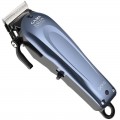Fixed combs
Clippers and trimmers are often equipped with fixed-height removable combs. The more combs in the kit, the smoother transitions the device can make. The standard set usually includes 3-5 combs, more advanced models may have 7-10 combs of a fixed height in a set.
Haircut length
The cutting height is influenced by the type of cutting element and the inclusion of detachable combs. Toothed blades can trim hair as short as 1 mm. By coupling a toothed blade with a detachable comb, the cutting height can range from 2-3 to 20, and even 30 mm – the precise height hinges on the provided comb attachments. There are defined minimum and maximum cutting heights. The minimum pertains to the blade's inherent capabilities, devoid of attachments. The maximum cutting height is determined by the detachable comb type.
Number of length settings
The number of haircut length options provided in the design of the clipper or the design of the nozzle. The more such options, the more versatile the clipper and the more cutting options it provides.
Blade width
The width of the operating tool (blade) of the clipper. A wide blade is important for head hair trimmers, as it allows you to capture more hair in one pass and cuts faster. In turn, beard and mustache clippers use narrower knives, which is useful for fine work to give facial hair the desired shape.
Power
The performance of the tool, the maximum rotation speed of the motor and how well the device handles with thick and coarse hair depends on the power of the electric motor. So, for cutting thick head hair, you need a clipper with a power of at least 15 W, the performance of such a device is usually enough to ensure a motor rotation speed of 10,000 rpm. But there are also more
powerful clippers(from 20 W). Trimmers for beards and mustaches usually need 5 W of power. Such models most often have a performance of 3,000 – 5,000 rpm.
Blades material/coating
—
Stainless steel. The standout feature of stainless steel is its exceptional resistance to rusting. When the clipper or trimmer boasts a sealed casing, the stainless steel cutting head can be conveniently cleaned using water pressure. While stainless steel is common in lower-tier devices and its blades can endure high temperatures, they tend to lose sharpness relatively swiftly.
—
Titanium. Titanium alloys showcase impressive durability against substantial mechanical strain. The titanium cutting edge adeptly manages hair of various thicknesses and densities, retaining its sharpness admirably. Tools equipped with a titanium blade are reliable for frequent usage, notably in beauty salons. However, the drawback lies in their notably steep expense.
—
Ceramic. Ceramic offers remarkable strength; its blades remain cool and sharp over time. Machines or trimmers featuring ceramic blades effortlessly handle even the thickest hair, allowing for frequent and prolonged use. Interestingly, models with ceramic blades often come at a more affordable price compared to those with titanium blades. Nonetheless, fragility is a significant drawback of ceramics; these blades are susceptible to damage from impacts and falls. Clippers and trimmers that are equipped with a ceramic cutting part must be handled with extreme delicacy.
—
Titanium ceramics.... Blades made of ceramic with a high titanium content. Ceramic in the context of the material used improves cutting performance, reduces friction and maintains a sharpness for a long time, and the titanium coating gives the blades strength, provides resistance to wear and corrosion. Titanium-ceramic blades are good for cutting coarse, thick hair, but they are quite expensive.
— Diamond. Diamond-coated blades have increased edge strength. Typically, these blades are based on steel, most often stainless, but thanks to diamond coating, the knife acquires higher reliability and durability. Of course, the presence of diamond coating on the blade significantly increases the cost of the device.
— Steel. Steel blades are the budget-friendly option. Steel performs effectively in devices used sporadically, mainly for home purposes. Although steel edges tend to lose sharpness relatively swiftly, their durability can be enhanced through the application of protective coatings like diamond, ceramic, or titanium. Clippers or trimmers with uncoated steel blades typically fall into the low-cost category.
— Graphite. Graphite coating is typical for stainless steel blades, it allows the blade to glide more easily through hair and skin and generally increases the efficiency and convenience of working with such a device. Most often, detachable trimmer blades are equipped with graphite coating.Operating time
The typical duration of uninterrupted operation for a clipper powered by a self-contained source (battery or rechargeable batteries, refer to Power Source) without requiring a recharge or battery replacement. Extended continuous operation time becomes particularly crucial when intending to use the clipper in locations where recharging or battery changes are unavailable, such as during long trips.
Charging time
Time to fully (from 0 to 100%) charge the battery of the clipper. For rare cases of using the model, charging time is not so relevant, but for everyday use it is better to choose
fast charging clippers.
Charge level indicator
The charge level indicator allows you to know the status of the battery, its degree of charge. Achieved using the built-in display or LEDs.
